A Comprehensive Analysis of Vincent van Gogh's Iconic Sunflower Series
VerifiedAdded on 2022/08/27
|8
|2127
|14
Essay
AI Summary
This essay provides an in-depth analysis of Vincent van Gogh's renowned Sunflower series. It examines the historical context, the artist's techniques, and the symbolism embedded within the paintings. The essay explores Van Gogh's use of color, particularly his fascination with yellow, and how it contributes to the emotional impact of the artwork. It discusses the medium of oil on canvas and its flexibility, allowing the artist to convey his vision of life and death. The essay also delves into the cultural and personal significance of sunflowers, their representation of loyalty, happiness, and the artist's own personality. Furthermore, the essay highlights the evolution of the series, discussing different versions of the paintings and their contrasting backgrounds. It touches upon the influence of other artists, the emotional impact of the paintings, and their enduring appeal in both pre- and post-war periods. The essay concludes by emphasizing the lasting influence of Van Gogh's work on modern artists and designers, asserting that the paintings continue to resonate with audiences, conveying messages of strength, happiness, and gratitude.
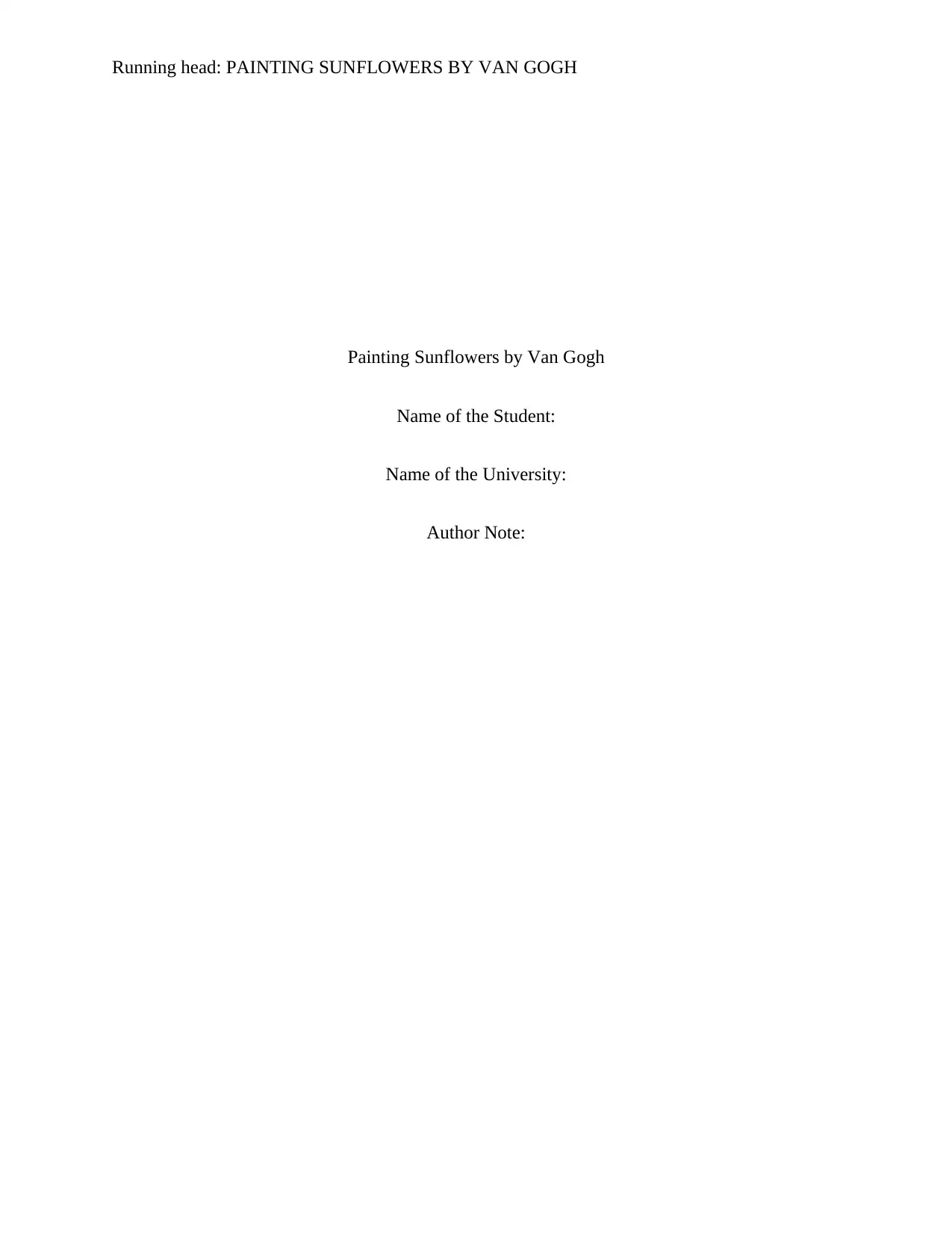
Running head: PAINTING SUNFLOWERS BY VAN GOGH
Painting Sunflowers by Van Gogh
Name of the Student:
Name of the University:
Author Note:
Painting Sunflowers by Van Gogh
Name of the Student:
Name of the University:
Author Note:
Paraphrase This Document
Need a fresh take? Get an instant paraphrase of this document with our AI Paraphraser
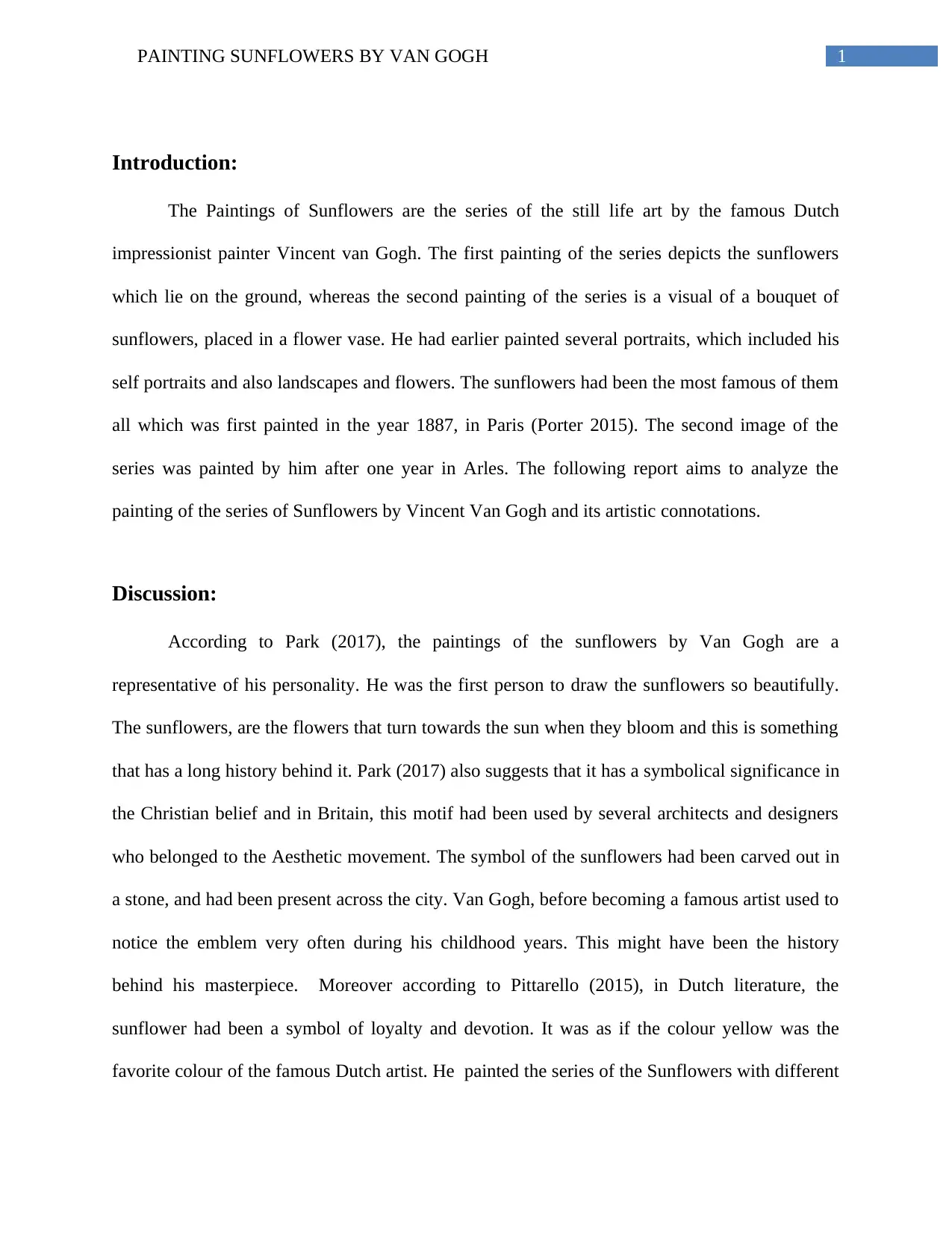
1PAINTING SUNFLOWERS BY VAN GOGH
Introduction:
The Paintings of Sunflowers are the series of the still life art by the famous Dutch
impressionist painter Vincent van Gogh. The first painting of the series depicts the sunflowers
which lie on the ground, whereas the second painting of the series is a visual of a bouquet of
sunflowers, placed in a flower vase. He had earlier painted several portraits, which included his
self portraits and also landscapes and flowers. The sunflowers had been the most famous of them
all which was first painted in the year 1887, in Paris (Porter 2015). The second image of the
series was painted by him after one year in Arles. The following report aims to analyze the
painting of the series of Sunflowers by Vincent Van Gogh and its artistic connotations.
Discussion:
According to Park (2017), the paintings of the sunflowers by Van Gogh are a
representative of his personality. He was the first person to draw the sunflowers so beautifully.
The sunflowers, are the flowers that turn towards the sun when they bloom and this is something
that has a long history behind it. Park (2017) also suggests that it has a symbolical significance in
the Christian belief and in Britain, this motif had been used by several architects and designers
who belonged to the Aesthetic movement. The symbol of the sunflowers had been carved out in
a stone, and had been present across the city. Van Gogh, before becoming a famous artist used to
notice the emblem very often during his childhood years. This might have been the history
behind his masterpiece. Moreover according to Pittarello (2015), in Dutch literature, the
sunflower had been a symbol of loyalty and devotion. It was as if the colour yellow was the
favorite colour of the famous Dutch artist. He painted the series of the Sunflowers with different
Introduction:
The Paintings of Sunflowers are the series of the still life art by the famous Dutch
impressionist painter Vincent van Gogh. The first painting of the series depicts the sunflowers
which lie on the ground, whereas the second painting of the series is a visual of a bouquet of
sunflowers, placed in a flower vase. He had earlier painted several portraits, which included his
self portraits and also landscapes and flowers. The sunflowers had been the most famous of them
all which was first painted in the year 1887, in Paris (Porter 2015). The second image of the
series was painted by him after one year in Arles. The following report aims to analyze the
painting of the series of Sunflowers by Vincent Van Gogh and its artistic connotations.
Discussion:
According to Park (2017), the paintings of the sunflowers by Van Gogh are a
representative of his personality. He was the first person to draw the sunflowers so beautifully.
The sunflowers, are the flowers that turn towards the sun when they bloom and this is something
that has a long history behind it. Park (2017) also suggests that it has a symbolical significance in
the Christian belief and in Britain, this motif had been used by several architects and designers
who belonged to the Aesthetic movement. The symbol of the sunflowers had been carved out in
a stone, and had been present across the city. Van Gogh, before becoming a famous artist used to
notice the emblem very often during his childhood years. This might have been the history
behind his masterpiece. Moreover according to Pittarello (2015), in Dutch literature, the
sunflower had been a symbol of loyalty and devotion. It was as if the colour yellow was the
favorite colour of the famous Dutch artist. He painted the series of the Sunflowers with different
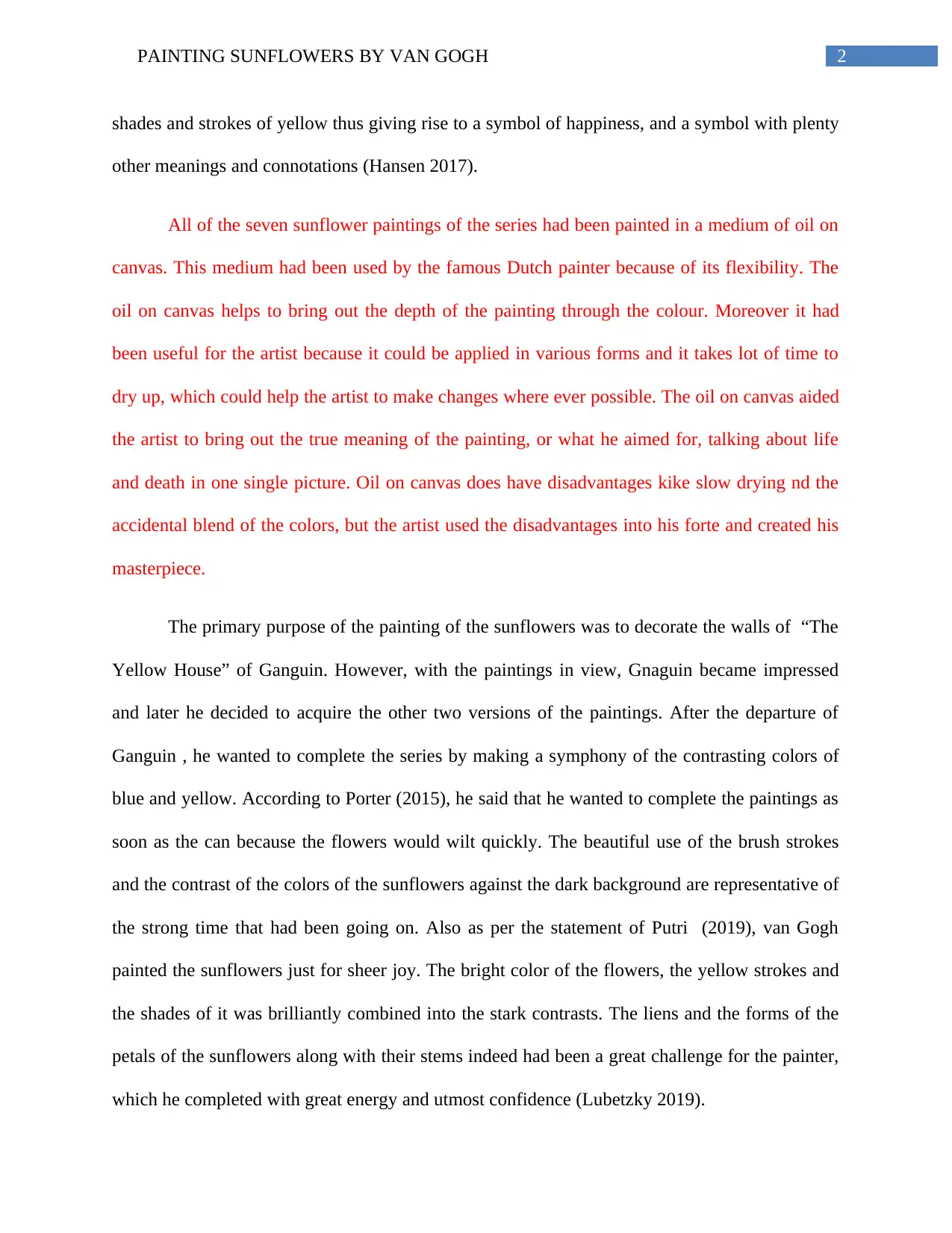
2PAINTING SUNFLOWERS BY VAN GOGH
shades and strokes of yellow thus giving rise to a symbol of happiness, and a symbol with plenty
other meanings and connotations (Hansen 2017).
All of the seven sunflower paintings of the series had been painted in a medium of oil on
canvas. This medium had been used by the famous Dutch painter because of its flexibility. The
oil on canvas helps to bring out the depth of the painting through the colour. Moreover it had
been useful for the artist because it could be applied in various forms and it takes lot of time to
dry up, which could help the artist to make changes where ever possible. The oil on canvas aided
the artist to bring out the true meaning of the painting, or what he aimed for, talking about life
and death in one single picture. Oil on canvas does have disadvantages kike slow drying nd the
accidental blend of the colors, but the artist used the disadvantages into his forte and created his
masterpiece.
The primary purpose of the painting of the sunflowers was to decorate the walls of “The
Yellow House” of Ganguin. However, with the paintings in view, Gnaguin became impressed
and later he decided to acquire the other two versions of the paintings. After the departure of
Ganguin , he wanted to complete the series by making a symphony of the contrasting colors of
blue and yellow. According to Porter (2015), he said that he wanted to complete the paintings as
soon as the can because the flowers would wilt quickly. The beautiful use of the brush strokes
and the contrast of the colors of the sunflowers against the dark background are representative of
the strong time that had been going on. Also as per the statement of Putri (2019), van Gogh
painted the sunflowers just for sheer joy. The bright color of the flowers, the yellow strokes and
the shades of it was brilliantly combined into the stark contrasts. The liens and the forms of the
petals of the sunflowers along with their stems indeed had been a great challenge for the painter,
which he completed with great energy and utmost confidence (Lubetzky 2019).
shades and strokes of yellow thus giving rise to a symbol of happiness, and a symbol with plenty
other meanings and connotations (Hansen 2017).
All of the seven sunflower paintings of the series had been painted in a medium of oil on
canvas. This medium had been used by the famous Dutch painter because of its flexibility. The
oil on canvas helps to bring out the depth of the painting through the colour. Moreover it had
been useful for the artist because it could be applied in various forms and it takes lot of time to
dry up, which could help the artist to make changes where ever possible. The oil on canvas aided
the artist to bring out the true meaning of the painting, or what he aimed for, talking about life
and death in one single picture. Oil on canvas does have disadvantages kike slow drying nd the
accidental blend of the colors, but the artist used the disadvantages into his forte and created his
masterpiece.
The primary purpose of the painting of the sunflowers was to decorate the walls of “The
Yellow House” of Ganguin. However, with the paintings in view, Gnaguin became impressed
and later he decided to acquire the other two versions of the paintings. After the departure of
Ganguin , he wanted to complete the series by making a symphony of the contrasting colors of
blue and yellow. According to Porter (2015), he said that he wanted to complete the paintings as
soon as the can because the flowers would wilt quickly. The beautiful use of the brush strokes
and the contrast of the colors of the sunflowers against the dark background are representative of
the strong time that had been going on. Also as per the statement of Putri (2019), van Gogh
painted the sunflowers just for sheer joy. The bright color of the flowers, the yellow strokes and
the shades of it was brilliantly combined into the stark contrasts. The liens and the forms of the
petals of the sunflowers along with their stems indeed had been a great challenge for the painter,
which he completed with great energy and utmost confidence (Lubetzky 2019).
⊘ This is a preview!⊘
Do you want full access?
Subscribe today to unlock all pages.

Trusted by 1+ million students worldwide
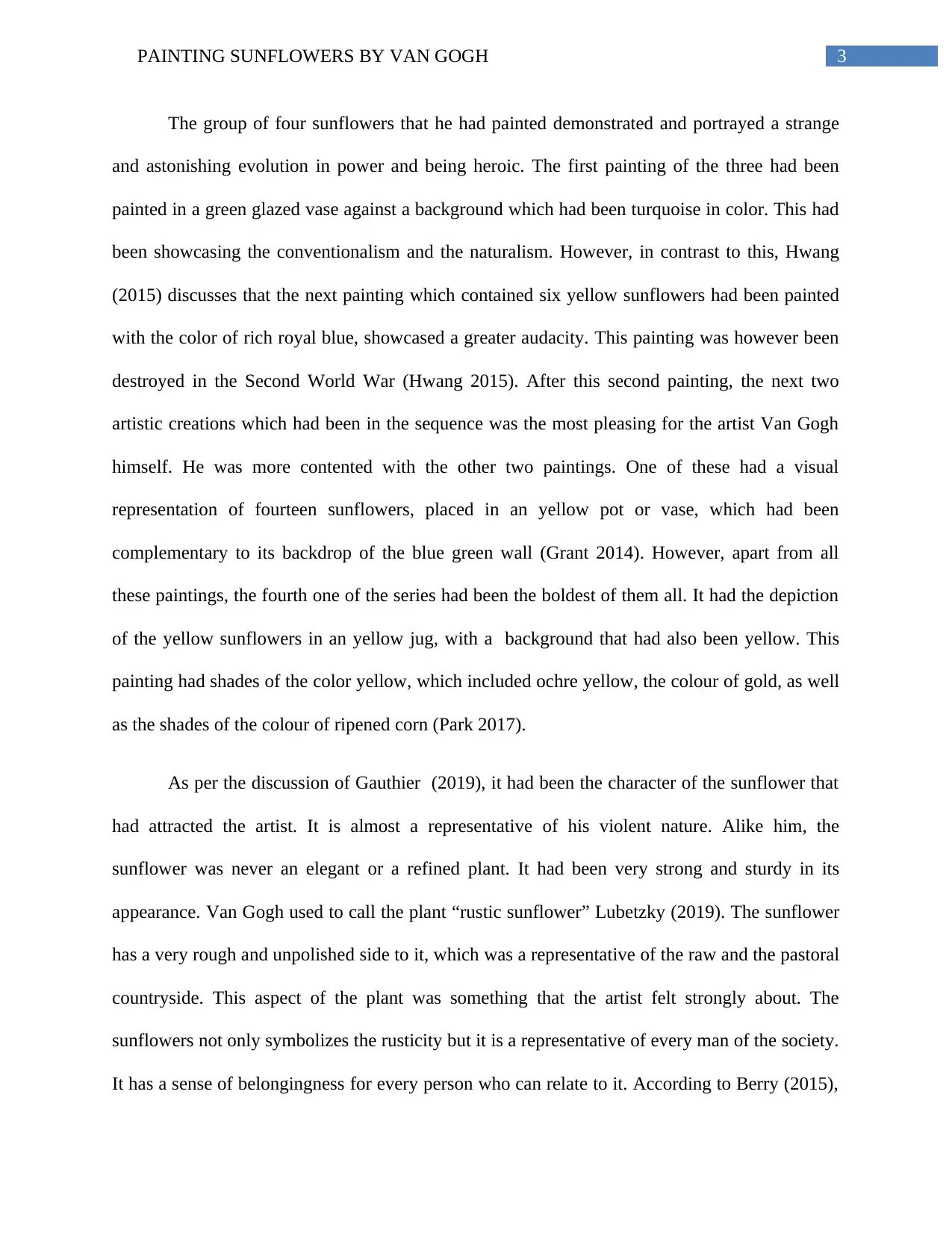
3PAINTING SUNFLOWERS BY VAN GOGH
The group of four sunflowers that he had painted demonstrated and portrayed a strange
and astonishing evolution in power and being heroic. The first painting of the three had been
painted in a green glazed vase against a background which had been turquoise in color. This had
been showcasing the conventionalism and the naturalism. However, in contrast to this, Hwang
(2015) discusses that the next painting which contained six yellow sunflowers had been painted
with the color of rich royal blue, showcased a greater audacity. This painting was however been
destroyed in the Second World War (Hwang 2015). After this second painting, the next two
artistic creations which had been in the sequence was the most pleasing for the artist Van Gogh
himself. He was more contented with the other two paintings. One of these had a visual
representation of fourteen sunflowers, placed in an yellow pot or vase, which had been
complementary to its backdrop of the blue green wall (Grant 2014). However, apart from all
these paintings, the fourth one of the series had been the boldest of them all. It had the depiction
of the yellow sunflowers in an yellow jug, with a background that had also been yellow. This
painting had shades of the color yellow, which included ochre yellow, the colour of gold, as well
as the shades of the colour of ripened corn (Park 2017).
As per the discussion of Gauthier (2019), it had been the character of the sunflower that
had attracted the artist. It is almost a representative of his violent nature. Alike him, the
sunflower was never an elegant or a refined plant. It had been very strong and sturdy in its
appearance. Van Gogh used to call the plant “rustic sunflower” Lubetzky (2019). The sunflower
has a very rough and unpolished side to it, which was a representative of the raw and the pastoral
countryside. This aspect of the plant was something that the artist felt strongly about. The
sunflowers not only symbolizes the rusticity but it is a representative of every man of the society.
It has a sense of belongingness for every person who can relate to it. According to Berry (2015),
The group of four sunflowers that he had painted demonstrated and portrayed a strange
and astonishing evolution in power and being heroic. The first painting of the three had been
painted in a green glazed vase against a background which had been turquoise in color. This had
been showcasing the conventionalism and the naturalism. However, in contrast to this, Hwang
(2015) discusses that the next painting which contained six yellow sunflowers had been painted
with the color of rich royal blue, showcased a greater audacity. This painting was however been
destroyed in the Second World War (Hwang 2015). After this second painting, the next two
artistic creations which had been in the sequence was the most pleasing for the artist Van Gogh
himself. He was more contented with the other two paintings. One of these had a visual
representation of fourteen sunflowers, placed in an yellow pot or vase, which had been
complementary to its backdrop of the blue green wall (Grant 2014). However, apart from all
these paintings, the fourth one of the series had been the boldest of them all. It had the depiction
of the yellow sunflowers in an yellow jug, with a background that had also been yellow. This
painting had shades of the color yellow, which included ochre yellow, the colour of gold, as well
as the shades of the colour of ripened corn (Park 2017).
As per the discussion of Gauthier (2019), it had been the character of the sunflower that
had attracted the artist. It is almost a representative of his violent nature. Alike him, the
sunflower was never an elegant or a refined plant. It had been very strong and sturdy in its
appearance. Van Gogh used to call the plant “rustic sunflower” Lubetzky (2019). The sunflower
has a very rough and unpolished side to it, which was a representative of the raw and the pastoral
countryside. This aspect of the plant was something that the artist felt strongly about. The
sunflowers not only symbolizes the rusticity but it is a representative of every man of the society.
It has a sense of belongingness for every person who can relate to it. According to Berry (2015),
Paraphrase This Document
Need a fresh take? Get an instant paraphrase of this document with our AI Paraphraser
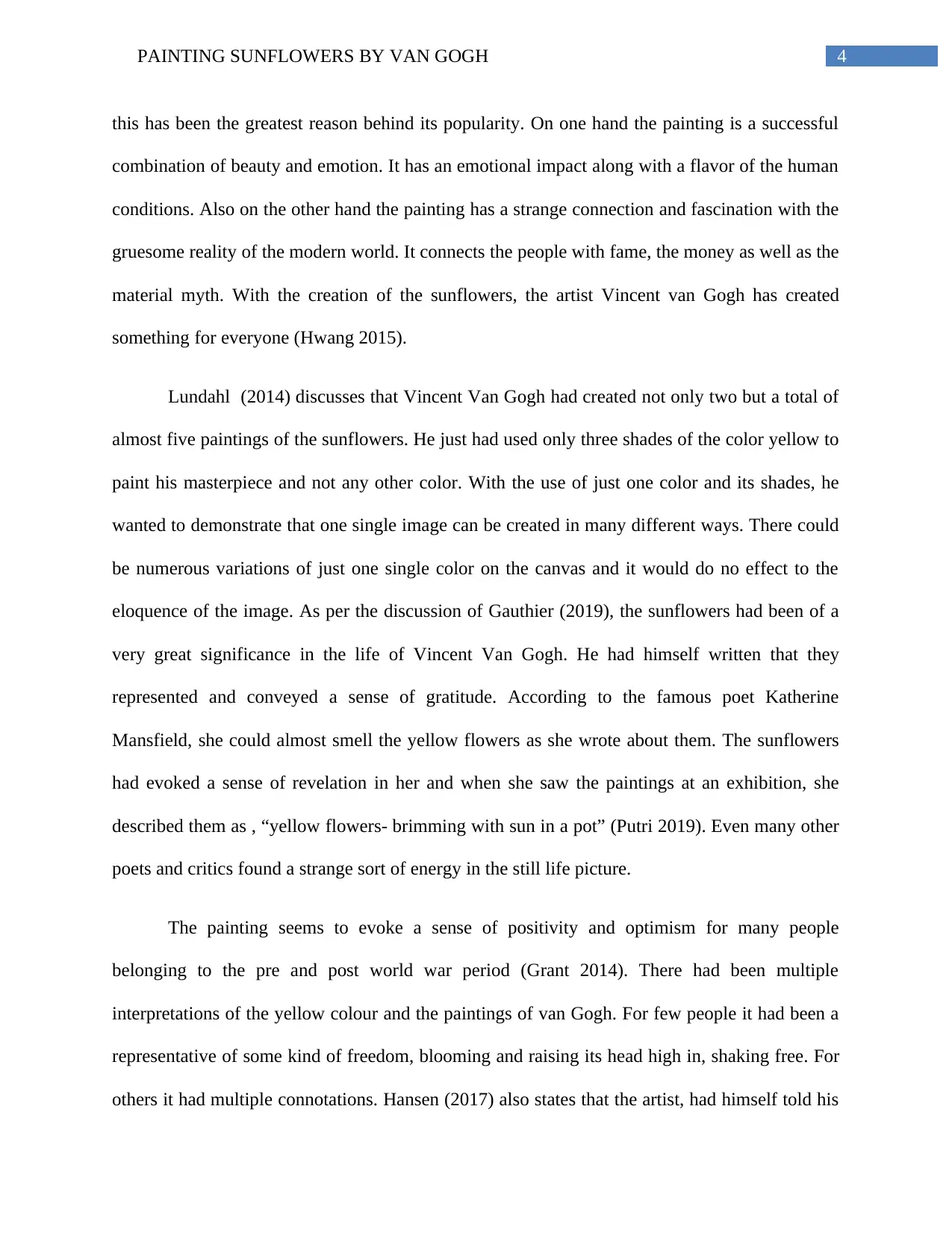
4PAINTING SUNFLOWERS BY VAN GOGH
this has been the greatest reason behind its popularity. On one hand the painting is a successful
combination of beauty and emotion. It has an emotional impact along with a flavor of the human
conditions. Also on the other hand the painting has a strange connection and fascination with the
gruesome reality of the modern world. It connects the people with fame, the money as well as the
material myth. With the creation of the sunflowers, the artist Vincent van Gogh has created
something for everyone (Hwang 2015).
Lundahl (2014) discusses that Vincent Van Gogh had created not only two but a total of
almost five paintings of the sunflowers. He just had used only three shades of the color yellow to
paint his masterpiece and not any other color. With the use of just one color and its shades, he
wanted to demonstrate that one single image can be created in many different ways. There could
be numerous variations of just one single color on the canvas and it would do no effect to the
eloquence of the image. As per the discussion of Gauthier (2019), the sunflowers had been of a
very great significance in the life of Vincent Van Gogh. He had himself written that they
represented and conveyed a sense of gratitude. According to the famous poet Katherine
Mansfield, she could almost smell the yellow flowers as she wrote about them. The sunflowers
had evoked a sense of revelation in her and when she saw the paintings at an exhibition, she
described them as , “yellow flowers- brimming with sun in a pot” (Putri 2019). Even many other
poets and critics found a strange sort of energy in the still life picture.
The painting seems to evoke a sense of positivity and optimism for many people
belonging to the pre and post world war period (Grant 2014). There had been multiple
interpretations of the yellow colour and the paintings of van Gogh. For few people it had been a
representative of some kind of freedom, blooming and raising its head high in, shaking free. For
others it had multiple connotations. Hansen (2017) also states that the artist, had himself told his
this has been the greatest reason behind its popularity. On one hand the painting is a successful
combination of beauty and emotion. It has an emotional impact along with a flavor of the human
conditions. Also on the other hand the painting has a strange connection and fascination with the
gruesome reality of the modern world. It connects the people with fame, the money as well as the
material myth. With the creation of the sunflowers, the artist Vincent van Gogh has created
something for everyone (Hwang 2015).
Lundahl (2014) discusses that Vincent Van Gogh had created not only two but a total of
almost five paintings of the sunflowers. He just had used only three shades of the color yellow to
paint his masterpiece and not any other color. With the use of just one color and its shades, he
wanted to demonstrate that one single image can be created in many different ways. There could
be numerous variations of just one single color on the canvas and it would do no effect to the
eloquence of the image. As per the discussion of Gauthier (2019), the sunflowers had been of a
very great significance in the life of Vincent Van Gogh. He had himself written that they
represented and conveyed a sense of gratitude. According to the famous poet Katherine
Mansfield, she could almost smell the yellow flowers as she wrote about them. The sunflowers
had evoked a sense of revelation in her and when she saw the paintings at an exhibition, she
described them as , “yellow flowers- brimming with sun in a pot” (Putri 2019). Even many other
poets and critics found a strange sort of energy in the still life picture.
The painting seems to evoke a sense of positivity and optimism for many people
belonging to the pre and post world war period (Grant 2014). There had been multiple
interpretations of the yellow colour and the paintings of van Gogh. For few people it had been a
representative of some kind of freedom, blooming and raising its head high in, shaking free. For
others it had multiple connotations. Hansen (2017) also states that the artist, had himself told his
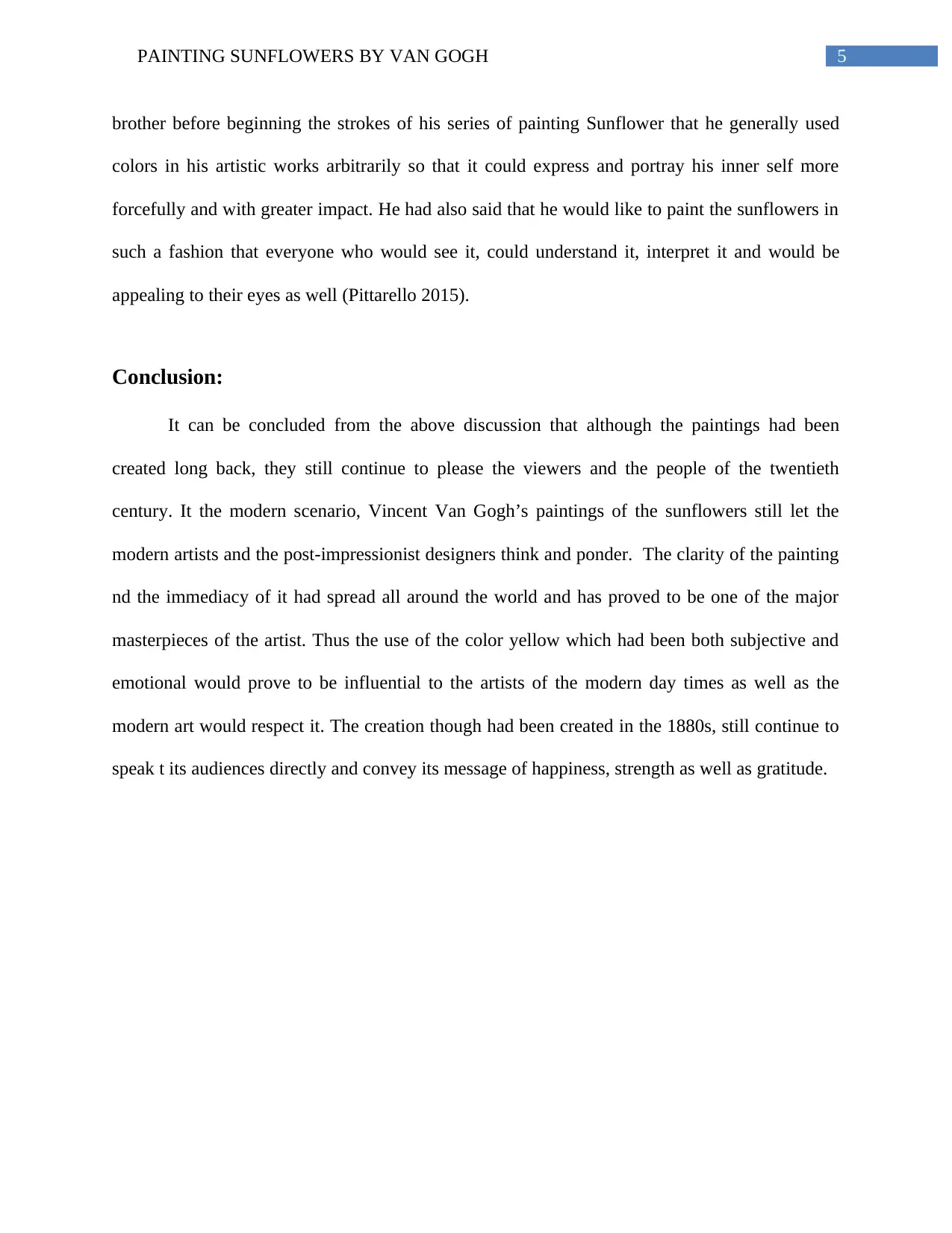
5PAINTING SUNFLOWERS BY VAN GOGH
brother before beginning the strokes of his series of painting Sunflower that he generally used
colors in his artistic works arbitrarily so that it could express and portray his inner self more
forcefully and with greater impact. He had also said that he would like to paint the sunflowers in
such a fashion that everyone who would see it, could understand it, interpret it and would be
appealing to their eyes as well (Pittarello 2015).
Conclusion:
It can be concluded from the above discussion that although the paintings had been
created long back, they still continue to please the viewers and the people of the twentieth
century. It the modern scenario, Vincent Van Gogh’s paintings of the sunflowers still let the
modern artists and the post-impressionist designers think and ponder. The clarity of the painting
nd the immediacy of it had spread all around the world and has proved to be one of the major
masterpieces of the artist. Thus the use of the color yellow which had been both subjective and
emotional would prove to be influential to the artists of the modern day times as well as the
modern art would respect it. The creation though had been created in the 1880s, still continue to
speak t its audiences directly and convey its message of happiness, strength as well as gratitude.
brother before beginning the strokes of his series of painting Sunflower that he generally used
colors in his artistic works arbitrarily so that it could express and portray his inner self more
forcefully and with greater impact. He had also said that he would like to paint the sunflowers in
such a fashion that everyone who would see it, could understand it, interpret it and would be
appealing to their eyes as well (Pittarello 2015).
Conclusion:
It can be concluded from the above discussion that although the paintings had been
created long back, they still continue to please the viewers and the people of the twentieth
century. It the modern scenario, Vincent Van Gogh’s paintings of the sunflowers still let the
modern artists and the post-impressionist designers think and ponder. The clarity of the painting
nd the immediacy of it had spread all around the world and has proved to be one of the major
masterpieces of the artist. Thus the use of the color yellow which had been both subjective and
emotional would prove to be influential to the artists of the modern day times as well as the
modern art would respect it. The creation though had been created in the 1880s, still continue to
speak t its audiences directly and convey its message of happiness, strength as well as gratitude.
⊘ This is a preview!⊘
Do you want full access?
Subscribe today to unlock all pages.

Trusted by 1+ million students worldwide
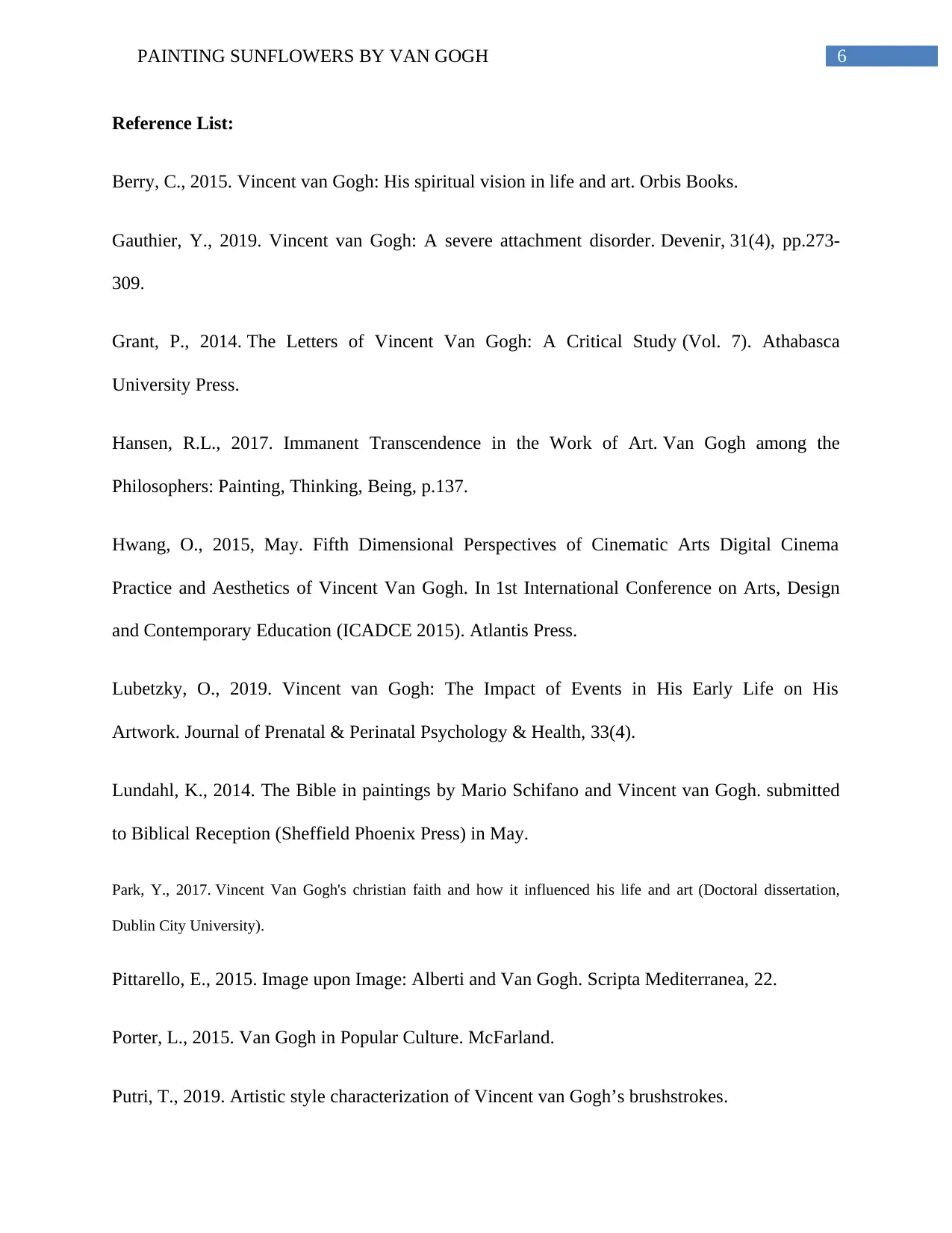
6PAINTING SUNFLOWERS BY VAN GOGH
Reference List:
Berry, C., 2015. Vincent van Gogh: His spiritual vision in life and art. Orbis Books.
Gauthier, Y., 2019. Vincent van Gogh: A severe attachment disorder. Devenir, 31(4), pp.273-
309.
Grant, P., 2014. The Letters of Vincent Van Gogh: A Critical Study (Vol. 7). Athabasca
University Press.
Hansen, R.L., 2017. Immanent Transcendence in the Work of Art. Van Gogh among the
Philosophers: Painting, Thinking, Being, p.137.
Hwang, O., 2015, May. Fifth Dimensional Perspectives of Cinematic Arts Digital Cinema
Practice and Aesthetics of Vincent Van Gogh. In 1st International Conference on Arts, Design
and Contemporary Education (ICADCE 2015). Atlantis Press.
Lubetzky, O., 2019. Vincent van Gogh: The Impact of Events in His Early Life on His
Artwork. Journal of Prenatal & Perinatal Psychology & Health, 33(4).
Lundahl, K., 2014. The Bible in paintings by Mario Schifano and Vincent van Gogh. submitted
to Biblical Reception (Sheffield Phoenix Press) in May.
Park, Y., 2017. Vincent Van Gogh's christian faith and how it influenced his life and art (Doctoral dissertation,
Dublin City University).
Pittarello, E., 2015. Image upon Image: Alberti and Van Gogh. Scripta Mediterranea, 22.
Porter, L., 2015. Van Gogh in Popular Culture. McFarland.
Putri, T., 2019. Artistic style characterization of Vincent van Gogh’s brushstrokes.
Reference List:
Berry, C., 2015. Vincent van Gogh: His spiritual vision in life and art. Orbis Books.
Gauthier, Y., 2019. Vincent van Gogh: A severe attachment disorder. Devenir, 31(4), pp.273-
309.
Grant, P., 2014. The Letters of Vincent Van Gogh: A Critical Study (Vol. 7). Athabasca
University Press.
Hansen, R.L., 2017. Immanent Transcendence in the Work of Art. Van Gogh among the
Philosophers: Painting, Thinking, Being, p.137.
Hwang, O., 2015, May. Fifth Dimensional Perspectives of Cinematic Arts Digital Cinema
Practice and Aesthetics of Vincent Van Gogh. In 1st International Conference on Arts, Design
and Contemporary Education (ICADCE 2015). Atlantis Press.
Lubetzky, O., 2019. Vincent van Gogh: The Impact of Events in His Early Life on His
Artwork. Journal of Prenatal & Perinatal Psychology & Health, 33(4).
Lundahl, K., 2014. The Bible in paintings by Mario Schifano and Vincent van Gogh. submitted
to Biblical Reception (Sheffield Phoenix Press) in May.
Park, Y., 2017. Vincent Van Gogh's christian faith and how it influenced his life and art (Doctoral dissertation,
Dublin City University).
Pittarello, E., 2015. Image upon Image: Alberti and Van Gogh. Scripta Mediterranea, 22.
Porter, L., 2015. Van Gogh in Popular Culture. McFarland.
Putri, T., 2019. Artistic style characterization of Vincent van Gogh’s brushstrokes.
Paraphrase This Document
Need a fresh take? Get an instant paraphrase of this document with our AI Paraphraser

7PAINTING SUNFLOWERS BY VAN GOGH
1 out of 8
Related Documents
Your All-in-One AI-Powered Toolkit for Academic Success.
+13062052269
info@desklib.com
Available 24*7 on WhatsApp / Email
![[object Object]](/_next/static/media/star-bottom.7253800d.svg)
Unlock your academic potential
Copyright © 2020–2025 A2Z Services. All Rights Reserved. Developed and managed by ZUCOL.





